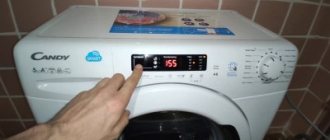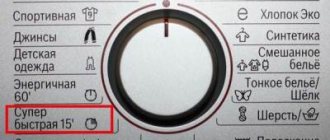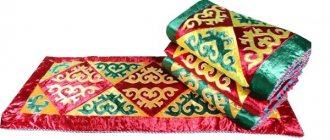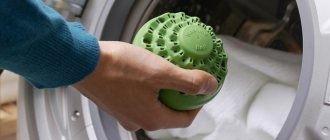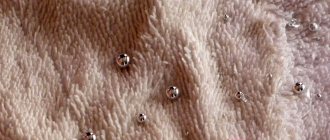A washing machine is one of the most necessary household appliances. Obviously, its importance cannot be underestimated. With their advent, homework has become much easier. However, many people are confused about which washing mode to choose, because there are so many of them!
Today there are many models on the market, each of which has at least 10 different methods of processing clothing. Why they are needed, how they differ and in what case each of them should be used will be described below.
Important Rules
Modern devices make the washing process as simple as possible. All you have to do is put down your laundry and select a program. However, despite the ease of use, problems sometimes arise.
To get clean laundry you need to know simple rules.
- It is necessary to distribute the laundry according to material, color and degree of soiling.
- Check for foreign objects in pockets. They must be empty.
- Remove metal objects from items, and close pockets and zippers.
- Knitted clothing should be placed inside out in the drum.
- Bedding should not be folded inside each other.
Thanks to the manipulations listed above, you can get not only well-washed items, but also maintain their quality.
Drying rules
The famous American shirt tailor Alexander Kabbaz advises drying shirts naturally and not in a dryer. However, you can still use this device, but you must select the No Heat option. Otherwise, you risk significantly reducing the life of the shirt. If you don't have a dryer, or if it doesn't have a No Heat option, you can hang your shirts on hangers—preferably plastic ones, not metal ones. Regular clothes dryers are also quite acceptable. In any case, avoid drying near a radiator or other heating devices.
Drying shirts on hangers
You should not unnecessarily dry it until it is completely dry: a shirt that is still slightly damp is easier to iron.
If the item has dried completely, you can sprinkle it with water and put it in a plastic bag so that it is evenly moistened. However, for some shirts this nuance does not matter - for example, for models made from non-iron or easy iron fabrics. They iron well in any case.
How to take care of your device
Any equipment tends to break down. Most often this happens not due to manufacturing defects or wear of parts, but due to improper operation.
To increase the life of the device, you should follow the recommendations for its use specified in the passport, and also follow certain rules:
- Each model has its own loading. Do not overload it in order to save time, water or electricity.
- For each type of fabric you need to choose your own mode.
- The powder must be poured into special sections (with the exception of liquid products).
- The amount of powder is taken in the dosages specified by the manufacturer.
When choosing equipment, many buyers look at the number of functions, but in fact use only a third of them. Don't overpay for extra features.
You might also be interested in:
What to do if the washing machine does not fill the drum with water - Causes of failure
Detergents
Depending on the composition of the product and the type of fabric of the product, household chemicals are selected.
Different fabrics require different detergents, the choice of which must take into account the etiology of contamination. White linen should be washed with two types of powders. White plain items can be washed with bleaching powder, and if items of clothing have stripes or large patterns, it is better to use a detergent for colored items.
To preserve the quality of wool and synthetic items, it is better to wash them with a liquid product rather than a regular detergent. Items of deep black color should be washed with a special product for black fabrics, otherwise streaks may remain. Be sure to use bleach when removing stains from tea, coffee, wine, and vegetables. When exposed to it, the dirt oxidizes and breaks down. The enzymes contained in many modern powders are suitable for cleaning things from protein contaminants. These biological catalysts can help remove stains from starch, cocoa, eggs, and blood.
Temperature
Each washing method has clear parameters that were obtained through long research and optimization of fabric cleaning processes.
All over the world, uniform standards have been adopted for all types of fabrics:
- 90-95 degrees is great for cotton and linen items. It is recommended to wash heavily soiled bed linen and towels.
- 60 degrees is the best option for synthetic products.
- 40 degrees – washing woolen items.
- Less than 40 degrees. Nowadays, most brands have begun to introduce a quick wash function (15 to 30 minutes), which uses water from 20 to 30 degrees. Most often, lightly soiled products are refreshed using this mode.
Do not wash colored items at high temperatures, as this may cause the paint to wash out.
If for some reason the temperature set by the manufacturer does not suit the user and he wants to change it, then it is very important to know what temperature is permissible for a particular product.
The label contains this information. It is not recommended to make it larger, as the product may fade, shrink or stretch.
Modes on the washing machine
It became customary to wash yellowed, gray, and complex stains at high temperatures. But this washing is fraught with several serious complications in the future. In addition, it is unwise to rely only on high temperature, because the cleanliness of things also depends on the products that are used during or before washing. A quality stain remover can work even in cool water.
Popular Features
Of course, each manufacturer tries to introduce its own characteristics into the washing process and develops new technologies. Despite this, the basic processing methods for each company will be the same:
- Daily. Water from 30 to 40 degrees. Duration from 15 to 40 minutes. In this mode, you need to lay clothes less than the maximum allowable weight. Place colored and white items separately. Suitable for lightly soiled clothes.
- Intense. The cycle duration is from 90 to 120 minutes, the water can vary from 60 to 90 degrees. You can wash any items that can withstand such temperatures. Best used for very dirty items.
- Fast. Water is less than 30 degrees, maximum procedure time is 40 minutes. This mode cannot remove serious stains. Good for refreshment.
- Economical. Duration no more than 1 hour, 40 degrees. The program works in such a way that it saves energy and water. Does not affect the quality of washing. Suitable for those who wash items with an average level of soil every day or several times a day.
- Soak. Duration from an hour to two at 40 degrees. Used to remove old stains. First, the item is soaked, and only after that the actual washing process begins.
The programs mentioned above are sufficient for everyday use. You can find such programs on any model, regardless of price or brand.
When changing the factory mode, it is best to use the instructions, which tell you in which case you need to increase the speed or reduce the temperature.
Additional functions
In addition to the main functions, the machines have many other programs. Usually they are used very rarely, but in some situations they will be vital.
- delicate - analogous to hand washing, here things are not subjected to serious mechanical stress, suitable for underwear;
- stain removal – removes even very stubborn stains without the use of aggressive chemicals;
- boiling - perfectly washes light-colored cotton items at high temperatures;
- wool – low temperature and gentle rocking of the drum guarantee high-quality cleaning of woolen products without any damage;
- drying - a mode that is not found in all models, the clothes are almost dry at the end;
- steam treatment is another additional function that helps kill all allergens or refresh laundry without getting wet, suitable for lightly soiled items and children's clothing.
Before turning on a “specific program”, you should read its description in the instructions. Its name does not always correspond to a specific type of clothing, because the material used to make it may differ.
Other useful features
Extra rinse – helps remove even minor traces of powder. It will be useful for families with allergies or small children.
Without spinning - indispensable for delicate clothes; their service life will be significantly extended.
Delayed rinse – the process of rinsing and spinning will be carried out some time after the end of the wash.
It helps in cases when the housewife realizes that she will not have time to hang up clean clothes, and they will lie wet in the tank.
Delay start is a convenient mode that allows you to finish the process by a certain time. The device starts working at a specified time and ends the procedure at a specific time.
For example, she will start at 6 in the morning, and at 8 things can already be hung up.
Obviously, it is impossible to develop and put into the machine a mode for each type of fabric or clothing, so most programs are universal for several types of items.
At high temperatures in the cotton or intensive mode, you can wash bed linen. The first one is best used in cases where it is very dirty.
To wash a down jacket, it is best to choose a gentle cycle with low temperature. The best option is gentle processing at low temperatures. A similar program is suitable for a winter jacket.
In both cases, you need to set a small number of spin speeds, but you should rinse twice, so if there is an additional rinse, you can select it immediately.
Features of models from different manufacturers
Almost every manufacturer develops its own programs that leave no doubt about their use.
- LG – sportswear and children's clothing, duvet;
- Indesit – sport, down and feather;
- Bosch – fine linens, synthetics, jeans;
- Beko – shirts, down;
- Samsung - dark fabrics.
Only manufacturers can answer how they differ from each other, however, for the end user their presence simplifies the selection process.
Sometimes the movement of the drum changes depending on the program - full rotation, swaying or rotation by two-thirds of its diameter. Almost all brands have rotation options, only the names differ.
Thanks to the emergence of different ways of rotating the drum in home devices, it has become possible to clean a jacket or down jacket without compromising their appearance and quality.
A little about spin
There are recommended spin speeds for different types of fabrics, which will help keep your favorite outfits in good condition longer.
- Cotton and linen can be spun even at 1400 rpm.
- Silk - no more than 400 rpm.
- Synthetics - up to 600 rpm.
- Jeans and woolen items - the best option is 800 rpm.
Before turning on the program, you must manually set the required number of revolutions. The device selects them by default, without discerning what kind of laundry is loaded into it. Many delicate items cannot be spun at all, especially at high speeds.
Proper ironing
When the ironing symbol is crossed out on the product label, it means that ironing of this type of fabric is prohibited. If we are talking about a thick woolen sweater, cashmere dress or coat, this does not pose a problem. But there are also thin blouses that do not tolerate contact with the iron. Only a steamer will help here.
ATTENTION: There are items whose design provides for a compressed effect. They are even washed by tying them in a knot. Ironing is also excluded for this category of products.
Thin fabrics of wool, silk, and viscose are ironed and steamed from the reverse side, carefully avoiding seams and fittings. The temperature regime is observed according to the instructions on the item’s label.

